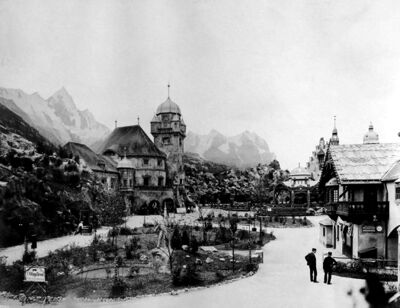Tyrolean Alps: Difference between revisions
No edit summary |
No edit summary |
||
| Line 8: | Line 8: | ||
| alternate_name = | | alternate_name = | ||
| location = [[The Pike]] | | location = [[The Pike]] | ||
| no_buildings = | | no_buildings = 21 | ||
| construction_cost= $750,000 (${{Format price|{{Inflation|US|750,000 |1904}}}} in {{Inflation/year|US}}) | | construction_cost= $750,000 (${{Format price|{{Inflation|US|750,000 |1904}}}} in {{Inflation/year|US}}) | ||
| furnishing_cost = | | furnishing_cost = | ||
| profit = $1,085,004 | | profit = $1,085,004(${{Format price|{{Inflation|US|1,085,004.05 |1904}}}} in {{Inflation/year|US}}) | ||
| owner = | | owner = Adolphus Busch | ||
| architect = | | architect = | ||
| dimensions = | | dimensions = | ||
| Line 45: | Line 45: | ||
==Description== | ==Description== | ||
The formidable attraction included 21 buildings and gigantic naturally-painted | The formidable attraction included 21 buildings and gigantic naturally-painted mountains of staff. | ||
Originated by Mr. Adolphus Busch, the re-creation of Alpine scenery and village centered on a snow-capped mountain tram-car ride through alpine valleys. Riders passed real cattle and goats as they ascended the peak. The ride stopped at an Alpine village of cottages and a chapel cut into the rocks. Visitors could visit a reproduction of Mozart's birthplace, where needlework, hats and other souvenir could be purchased. Tyrolean dancers and musicians entertained the crowds. Groups of peasants garbed in native dress as well as chorus groups performed concerts. | Originated by Mr. Adolphus Busch, the re-creation of Alpine scenery and village centered on a snow-capped mountain tram-car ride through alpine valleys. Riders passed real cattle and goats as they ascended the peak. The ride stopped at an Alpine village of cottages and a chapel cut into the rocks. Visitors could visit a reproduction of Mozart's birthplace, where needlework, hats and other souvenir could be purchased. Tyrolean dancers and musicians entertained the crowds. Groups of peasants garbed in native dress as well as chorus groups performed concerts. | ||
Latest revision as of 19:42, 9 March 2024
 | |
| Location | The Pike |
|---|---|
| No. of Buildings | 21 |
| Owner | Adolphus Busch |
| Construction | |
| Construction Cost | $750,000 ($22.6 million in 2021) |
| Proft | $1,085,004($32.7 million in 2021) |
Tyrolean Alps was a massive nine-acre scaled reproduction of the alpine region in Germany. It was given a grand location on The Pike and was the most expensive attraction at the Fair (three-quarters of a million dollars).
Etymology[edit | edit source]
Admission[edit | edit source]
The admission price was:
25 cents adult admission 15 cents children admission
additional adult 10 cents for Magic Grotto additional child 5 cents for Magic Grotto additional adult 10 cents for Royal Castle additional child 5 cents for Royal Castle additional adult 25 cents for Passion Play (extra 10 cents for reserved seat) additional child 5 cents for Passion Play (extra 10 cents for reserved seat)
25 cents adult admission,
15 cents children admission for Rail Excursion
Description[edit | edit source]
The formidable attraction included 21 buildings and gigantic naturally-painted mountains of staff.
Originated by Mr. Adolphus Busch, the re-creation of Alpine scenery and village centered on a snow-capped mountain tram-car ride through alpine valleys. Riders passed real cattle and goats as they ascended the peak. The ride stopped at an Alpine village of cottages and a chapel cut into the rocks. Visitors could visit a reproduction of Mozart's birthplace, where needlework, hats and other souvenir could be purchased. Tyrolean dancers and musicians entertained the crowds. Groups of peasants garbed in native dress as well as chorus groups performed concerts.
Patrons could also attend a performance of the Oberammergau Passion Play and enjoy coffee, tea and strudel at the café.
The Luchow-Faust Cafe had seating for 2,500 people and was catered by Tony Faust from St. Louis and August Luchow from New York City. It was billed as the largest German restaurant in the world.
For an extra fee, the tram could continue up the mountain to a reproduction of the Royal Castle. An elevator carried visitors to the mountain top where they could view a waterfall tumbling onto a lake.
After the Fair[edit | edit source]
Adolphus Busch purchased the attraction with an idea of using it as a summer attraction for theatre, but this was never completed.
